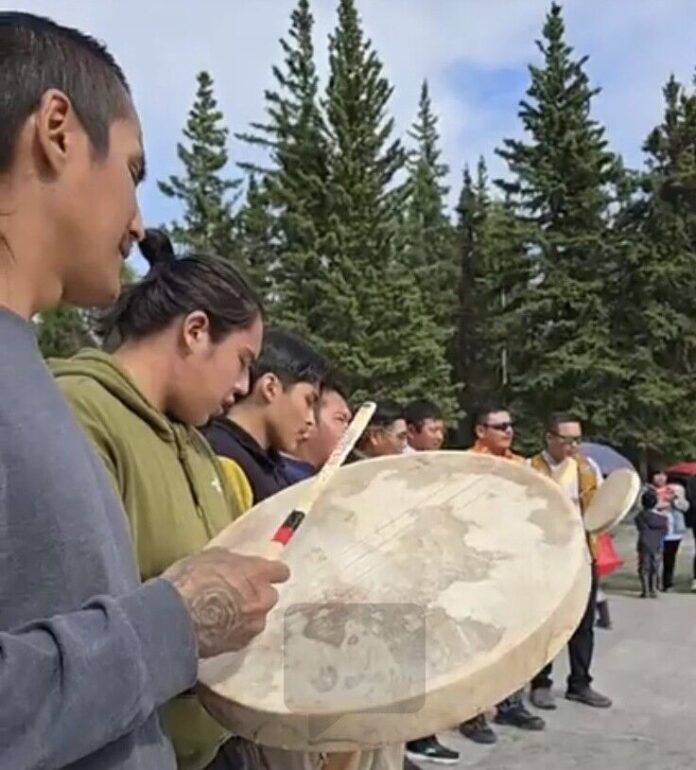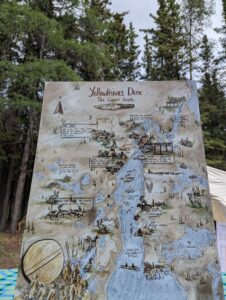As Indigenous Peoples Day festivities continued in the Samba K’e park in the city, the Yellowknives Dene Nation held a Feeding the Fire ceremony, followed by celebrations and activities at the Wiiliideh site on Yellowknife River.
“We’ve been doing this for thousands of years, travelling around, Feeding the Fire, after we shared everything we had, we stopped we ate and after we finished eating, we went around the fire. Everyone said a prayer, everybody gave thanks, and then fed the fire and through the fire fed the ancestors, asked them for help, asked them for guidance, to make sure we have a good day,” said Bobby Drygeese of the Yellowknives Dene Drummers, who led the ceremony.
Indigenous Day festivities took place across Chief Drygeese territory on June 21. Many folks who attended Samba K’e Park celebrations along with more people from across the territories, made their way to the Dene Nation’s Wiiliideh site.
The sun mixed with sunshowers continued and people took shelter under the canopies of trees and theh canopy over tables to take in the warmth of fresh fish cooked over a fire, homemade stew and handmade fried bannock and a cup of warm tea.
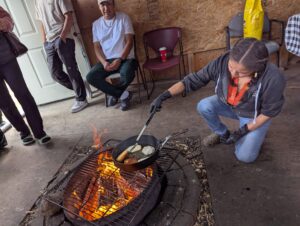
Youth were joined by Elders to fry bannock by an open fire. Elders gave guidance to youth and newcomers, on how to clean fish and cook fish, as folks cooked together by an open fire.
The smell of delicious bannock and fish cooked over the fire filled the air.
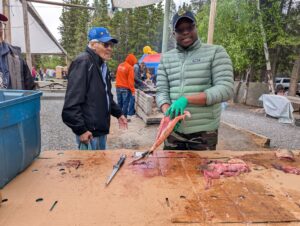
Everyone was welcome to sit at tables under a canopy of tall trees to eat fish, bannock, and stews.
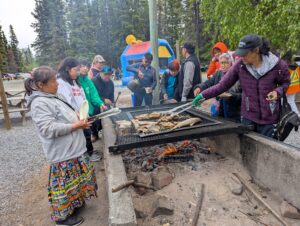
The Dene Drummers led the Feeding the Fire ceremony with everyone gathered around in a circle around the ceremonial fire, saying a prayer and offering tobacco.
Bobby Drygeese of the Dene Drummers spoke about the importance of the ceremony.
“We give thanks to the Creator for everything we have, we give thanks for this day, we give thanks to the Ancestors for being strong,” explained Drygeese.
“Each one of you are here because your family are strong people. Each one of you are here because your families survived wars and pandemics and floods and fires and earthquakes and all that stuff that happens out on the land,” he said.
The fire ceremony has deep significance for many reasons.
“Before there were any schools or hospitals people journeyed out on the land with their families. They all made fire somewhere. They all shared what they had,” said Drygeese.
Drygeese explained that the Elders or another community leader would make their way around the group gathered and everyone would make an offering like tobacco or food.
Working together, sharing and living in harmony on the land is inherent to Dene ways of life.
“We’ve been doing this for thousands of years, travelling around, Feeding the Fire, after we shared everything we had, we stopped we ate and after we finished eating, we went around the fire. Everyone said a prayer, everybody gave thanks, and then fed the fire and through the fire fed the ancestors, asked them for help, asked them for guidance, to make sure we have a good day,” explained Drygeese.
“Wherever people are journeying, wherever they are travelling, to make sure they have safe travels. Everybody helps each other out, to make sure they have a good hunt, a good gathering and each day ask for guidance so that nobody gets hurt.”
Drygeese explained that going back thousands and thousands of years ago, people would gather here at the Wiiliideh site in August to fish and make traditional dry fish.
“They would come here, they would fish some more and then theyll get all the canoes ready, their bows arrows everything ready for when they travel up towards the river towards the tundra.”
In August and September, when the caribou would come down, the Dene people would hunt carribou and they make dry smoked meat from their hunt. would use the hide of the caribou to make drums, bags, jackets, clothes, shoes and mits, explained Drygeese.
Drygeese reflected on his youth and going hunting with his family and how even since then times have changed quite a bit. Caribou have grown much more sparse.
“When I was a kid there was lots of caribou all around here,” he reflected.
Nowadays to hunt, people are having to travel further away from what is a traditional hunting ground for the Dene.
The Feeding the Fire ceremony began with a Prayer Song. Drygeese spoke about the song, which is about angels and about the sky watching over people to help protect them and guide them.
“When we’re out on the land, trying to thrive and survive, we will make sure that for today
everybody takes care of each other—everybody shares together, everybody laughs together, make sure that everybody is going to be helping each other.”
Drygeese spoke to everyone gathered about the importance of the waters to the Dene traditions and beliefs.
“Every spring we put our hands in the water, put our hands in our hair so we are part of the water we won’t be afraid to travel out on the lake, we won’t be afraid to travel out on the river,” said Drygeese as he shared in reflection of Dene traditions.
The crowd of Dene, First Nations, Metis, Inuit and non-Indigenous folks stood side by side, gathered in the circle, immersed in the words, songs and ceremony of the Dene. Many who took part described the ceremony as a time of healing and transformation.
After the Prayer Song and the Angel Song, the Dene Drummers performed the Journey Song.
An Elder accompanied by a youth, brought the tobacco to the fire, walking around the ceremonial fire before offering prayers and offering the tobacco into the fire.
Drygeese spoke about the importance of the ceremony to give thanks to the ancestors and as a way of honouring Dene traditions of caring and working together across families and communities. Then it was time to celebrate, with folks heading to activities and games
Everyone was welcome to take part in activities from canoe races to hide tanning, duck plucking, Elders games, balloon tossing and hand games demo.
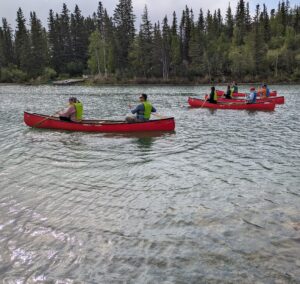
Hand games are traditional guessing games that are connected to traditional hunting practices. The game often involves teams who take turns hiding an object in one hand and the other team guessing which hand it is in.
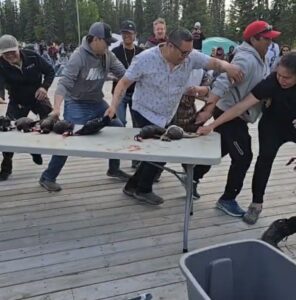
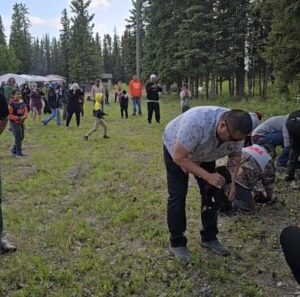
Vendors featured beautiful handmade drums, caribou antler jewelry made combining intricate beading with soft fur, traditional foods and treats. One vendor has been making hand made drums with caribou hide for decades, learning the tradition from Elders. He said the drum embodies many meanings, its circle symbolizing the cycle of life. The components of the drum represent the balance between positive and negative forces and the obstacles that stand in the way that can break the circle. The caribou hide is strong and flexible by nature and the drum is a symbol of that vitality and strength that comes from the land and the people of the land.
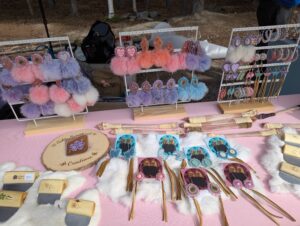
Throughout the afternoon folks headed to sewing tents, traditional craft tents and language tents to learn Dene languages.
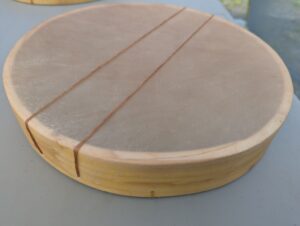
In the warm sun of the evening, the crowd gathered again for the traditional Drum Dance lead by the Dene Drummers, joining in round dances, honouring and celebrating life as the people of Turtle Island’s North have done since time immemorial.



